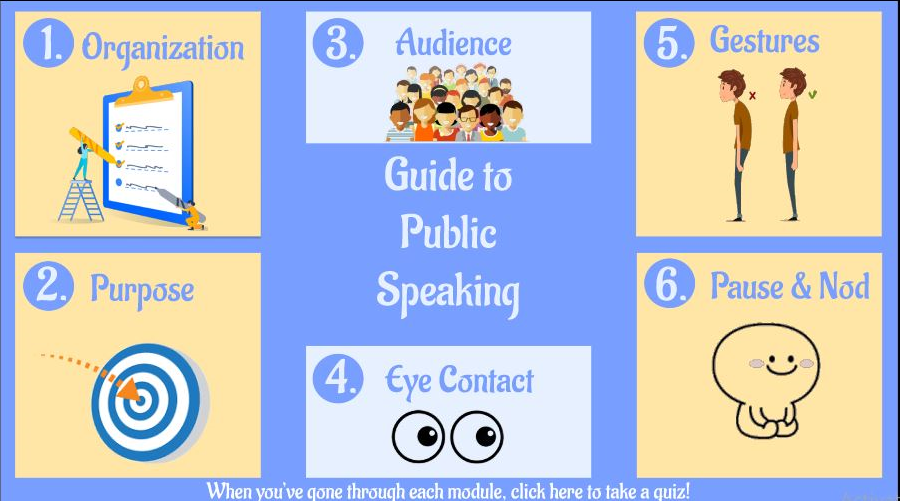Learning Outcomes
By the end of this learning session you should be able to:
- Identify the 6 different parts of a speech
- Identify the 3 main purposes of a public speech
- How to analyze and engage with your intended audience
- Make eye contact when presenting
- How to properly use gestures and have good posture for a speech
- When to pause and nod (non-verbal communication)

Introduction and Overview
Have you ever found yourself nervous or anxious about public speaking? We have curated an interactive infographics to help individuals improve their public speaking skills. These tips and tricks will help learners achieve the best results and engage properly with their audience. The interactive lesson our pod has created on Figma helps users have a greater understanding of how to effectively present a speech. Figma is an interactive multimedia platform that allows individuals to create applications for desktop and mobile devices. It provided our pod with the freedom we needed in order to create the best interactive infographic
Design Process
The design process began with identifying our goals. Our goals were to create an engaging and effective tool that would help users improve their public speaking skills. Through the research on our topic, the art of public speaking, our team brainstormed the most effective type of multimedia methods and principles that would be useful for delivering the topic.
Discussion
We decided that we wanted to create a multimedia object that used the dual-coding theory as it engages users through multiple sources like video, audio, graphics and pictures (Mac Mahon, 2013). We found that Figma was the best platform for this as it allows users to insert video lessons, design a presentation and add engaging graphics all in one platform.
We wanted the project to be interactive as active learning is more effective than passive learning. Active learning forces learners to engage with the material by thinking and analyzing the information (Queen’s University – Teaching and Learning, n.d.). It has also been found that formative assessment is greatly beneficial for students when learning new material. Formative assessment helps learners evaluate their understanding of the material and helps with longterm understanding on the topic (Queen’s University – Teaching and Learning, n.d.). We incorporated these principles by providing a quiz at the end of the infographic. Learners can quiz themselves and view what areas they may need extra revision in.
When designing the infographics we incorporated signalling and coherence principles throughout. The use of bold lettering, text sizes and numbering helped draw learning attention to key areas though the infographic. Signaling principle helps ensure that users do not miss key elements throughout the presentation (Mayer, 2014). Additionally, by applying the coherence principle we ensured that the infographic only contained vital information (Mayer, 2014). We removed unnecessary fluff to reduce learning fatigue.
Our goal when creating the interactive infographic was to ensure that our learners would walk away with improved public speaking skills. We applied the theories and principles learned throughout the course to provide an effective resource for learners.
References
Lake, R. (2020, April 14). Fear of public speaking statistics and how to Overcome Glossophobia. CreditDonkey. Retrieved December 2, 2021, from https://www.creditdonkey.com/fear-of-public-speaking-statistics.html.
Why and how body language is important in public speaking. Communicate your message with persuasion. (2019, November 16). Retrieved December 2, 2021, from https://www.speakwithpersuasion.com/learn/body-language/.
Assessment Types: Diagnostic, Formative and Summative (n.d.). Queens University – Teaching & Learning. Retrieved November 27, from https://www.queensu.ca/teachingandlearning/modules/assessments/09_s2_01_intro_section.html
What is Active Learning? (n.d.). Queens University – Teaching & Learning. Retrieved November 27, 2021, from https://www.queensu.ca/teachingandlearning/modules/active/04_what_is_active_learning.html
Mayer, R. E. (Ed.). (2014). The Cambridge Handbook of Multimedia Learning (2nd ed.). Cambridge University Press. https://doi.org/10.1017/CBO9781139547369
Mac Mahon, C. (2013). Dual Coding Theory & Multimedia Learning [Mp4]. https://vimeo.com/57440483



